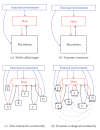Conceptualizing human microbiota: from multicelled organ to ecological community
- PMID: 19259327
- PMCID: PMC2648621
- DOI: 10.1155/2008/613979
Conceptualizing human microbiota: from multicelled organ to ecological community
Abstract
The microbiota of a typical, healthy human contains 10 times as many cells as the human body and incorporates bacteria, viruses, archea, protozoans, and fungi. This diverse microbiome (the collective genomes of the microbial symbionts that inhabit a human host) is essential for human functioning. We discuss the unstated assumptions and implications of current conceptualizations of human microbiota: (1) a single unit that interacts with the host and the external environment; a multicelled organ; (2) an assemblage of multiple taxa, but considered as a single unit in its interactions with the host; (3) an assemblage of multiple taxa, which each interacts with the host and the environment independently; and (4) a dynamic ecological community consisting of multiple taxa each potentially interacting with each other, the host, and the environment. Each conceptualization leads to different predictions, methodologies, and research strategies.
Figures


Similar articles
-
Microbial Hub Taxa Link Host and Abiotic Factors to Plant Microbiome Variation.PLoS Biol. 2016 Jan 20;14(1):e1002352. doi: 10.1371/journal.pbio.1002352. eCollection 2016 Jan. PLoS Biol. 2016. PMID: 26788878 Free PMC article.
-
The potential impact of gut microbiota on your health:Current status and future challenges.Asian Pac J Allergy Immunol. 2016 Dec;34(4):249-264. doi: 10.12932/AP0803. Asian Pac J Allergy Immunol. 2016. PMID: 28042926 Review.
-
Lotus japonicus Symbiosis Genes Impact Microbial Interactions between Symbionts and Multikingdom Commensal Communities.mBio. 2019 Oct 8;10(5):e01833-19. doi: 10.1128/mBio.01833-19. mBio. 2019. PMID: 31594815 Free PMC article.
-
Lupus: The microbiome angle.Immunobiology. 2018 Jun-Jul;223(6-7):460-465. doi: 10.1016/j.imbio.2017.11.004. Epub 2017 Nov 16. Immunobiology. 2018. PMID: 29478734 Review.
-
Crossing Kingdoms: How the Mycobiota and Fungal-Bacterial Interactions Impact Host Health and Disease.Infect Immun. 2021 Mar 17;89(4):e00648-20. doi: 10.1128/IAI.00648-20. Print 2021 Mar 17. Infect Immun. 2021. PMID: 33526565 Free PMC article. Review.
Cited by
-
Genomic approaches to studying the human microbiota.Nature. 2012 Sep 13;489(7415):250-6. doi: 10.1038/nature11553. Nature. 2012. PMID: 22972298 Free PMC article. Review.
-
Metaproteomics of the human gut microbiota: Challenges and contributions to other OMICS.Clin Mass Spectrom. 2019 Jun 4;14 Pt A:18-30. doi: 10.1016/j.clinms.2019.06.001. eCollection 2019 Sep. Clin Mass Spectrom. 2019. PMID: 34917758 Free PMC article. Review.
-
Novel perspectives on the role of the human microbiota in regenerative medicine and surgery.Biomed Rep. 2016 Nov;5(5):519-524. doi: 10.3892/br.2016.778. Epub 2016 Oct 11. Biomed Rep. 2016. PMID: 27882211 Free PMC article.
-
Molecular Accounting and Profiling of Human Respiratory Microbial Communities: Toward Precision Medicine by Targeting the Respiratory Microbiome for Disease Diagnosis and Treatment.Int J Mol Sci. 2023 Feb 17;24(4):4086. doi: 10.3390/ijms24044086. Int J Mol Sci. 2023. PMID: 36835503 Free PMC article. Review.
-
"What is the FDA Going to Think?": Negotiating Values through Reflective and Strategic Category Work in Microbiome Science.Sci Technol Human Values. 2015 Jan;40(1):71-95. Epub 2014 Aug 4. Sci Technol Human Values. 2015. PMID: 36119463 Free PMC article.
References
-
- Sekirov I, Finlay BB. Human and microbe: united we stand. Nature Medicine. 2006;12(7):736–737. - PubMed
-
- Clavell T, Haller D. Molecular interactions between bacteria, the epithelium, and the mucosal immune system in the intestinal tract: implications for chronic inflammation. Current Issues in Intestinal Microbiology. 2007;8(2):25–43. - PubMed
-
- Blaut M, Clavel T. Metabolic diversity of the intestinal microbiota: implications for health and disease. The Journal of Nutrition. 2007;137(3):751S–755S. - PubMed
-
- Fava F, Lovegrove JA, Gitau R, Jackson KG, Tuohy KM. The gut microbiota and lipid metabolism: implications for human health and coronary heart disease. Current Medicinal Chemistry. 2006;13(25):3005–3021. - PubMed
LinkOut - more resources
Full Text Sources

